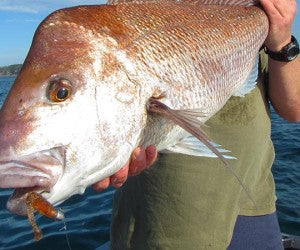Author: Paul Senior

Winter Morning can be amazing
Winter is setting in, retail fishing stores become quiet and the amount of boats heading out hunting fish dramatically drops. Why, I still think there is much thinking based around the Snapper leaving our waters and disappearing over winter. Where does this come from, I think it has filtered down through our fishing culture from the past. We used to have smaller slower boats which would make it difficult to venture outside the Waitmata harbour to the outer gulf where the snapper hang out during winter. I don’t know this for sure but I assume it may have something to do with it. Now days we have access to bigger faster boats, clothing and creature comforts that can make venturing out in to the Hauraki Gulf in winter a whole lot of fun. I tell you what if it’s a Monday morning in Auckland and mid-winter, the winds are light and the sun is shining it can be one of the best fishing experiences you can have. I for one look forward to a winter time high pressure system drifting on to the country, crisp clear winter days on the water are one of my favourite things to do.
Lure fishing for Snapper is still relatively new to New Zealand compared with the rest of the world, and there have been rumours like “Soft Baits don’t work in winter” or the fish are not aggressive in winter and won’t hit a lure. Well I can tell you it’s a load of bollocks; I often see snapper smashing all types and brands of soft baits in winter. The fishing can be full on. The biggest difference to Summer time is the bite times can be shorter, but when they feed they can go for it.
Winter time=Bigger snapper
For me there are two types of lure fishing styles I like to do in winter. The first is hunting winter time work ups. I learnt a lot about Pilchard behaviour watching TV not to long ago. There was a program on about the great sardine run off the coast of South Africa. The baitfish they were showing were the same as our pilchards here in New Zealand, and one point stood out that I did not know and that is Pilchards do not like hanging out in warm water, they like to follow fingers of cold water around. Quite the opposite to what some say and something I did not realise either. This explained Pilchards absence during mid-summer in the gulf when the water is 19-21 degrees, and why we find work ups all through winter time. From what I believe Pilchards like water less than 18 degrees Celsius. I have not used SST charts to try hunting pilchard schools yet, watch this space so the saying goes. We all know Snapper like to hang out with the baitfish. How do I go about finding work ups in winter? Well the best information comes from my mate Andy on the Dolphin Explorer boat who keeps me updated to where the work ups are holding. One recent discovery I have added to my work up finding arsenal is tidal heights. I find on larger tides when the current is moving fast which results in more water moving in and out of the Firth of Thames the pilchards can be found further south deeper in to the firth of Thames. I believe this to be quite true now ,so on big tide days or days around the full moon I will often head south in to the firth and often find the work ups way south. Last weekend the chatter on the VHF of vessels looking for work ups in the middle gulf was of despair, nobody could find the work ups. I followed gannets deep in to the firth and found a patch of activity that was spectacular and even better there was no one there. It seemed all the bait, birds and mammals were tucked up in to a corner deep in the firth of Thames. I also learnt that day to have faith in the gannets. I spotted through the binos a group of 3 gannets who had just left there colony and were heading in a definite direction, a few minutes later I spotted another squadron of 3 or 4 gannets heading the same way. This is all I could see and they were quite a few miles away. So I blindly headed in the direction they were flying for at least 10 miles and sure enough they were going to join in the feast. So if you see Gannets heading in a similar direction follow them they know what they’re doing and have some type of sense to know which way to go. I guess they can see a whole lot more than we can being up so high. I have said before my fishing experiences are always teaching me something new, one thing really sitting in my mind at the moment is trust the gannets, more than the sounder, more than groups of boats and more than recent information, if you see gannets all on a similar course of direction, follow them they know what they’re doing and are absolute masters at finding baitfish. I have also recently become more skilled at spotting whale spouts, when the sun is shining and you have land in the background such as the Coromandel Ranges, whale spouts can reflect sunlight and make them visible from many miles away. I now look for whale spouts more and seem to find them more often now I am more concentrated on finding them. Whales are a very good sign that there is bait in the area. So this is a case of using the right conditions of sunlight and land in the background to your advantage. When the conditions are right for spotting whale spouts give finding them a go. I am also realising more these days that the work ups will often be in the lee of land out of the wind. This thinking has come from experience charter fishing as I will often seek the calm waters at the foot of the coromandel ranges in a NE wind and I often find the work ups in the calmest waters. I drive along the coast until the wind is offshore from the land and as I get in to the calmer seas the work ups start to show up. Maybe the gannets and dolphin’s prefer hunting in calmer waters also?
I am in a constant change of how I fish also; my technique is always getting tweaked and adjusted as I discover new ways that work. The lures I use have also been changing, quite dramatically as of late. Out in the deeper waters I use Jitterbug Inchiku style lures, Slow Pitch Jigs, and Free Sliding Kabura Jigs, they all work well, in my opinion there is not one silver bullet lure, it depends on the day I have seen all three styles mentioned above out fish the other two many times over. Jitterbugs have been my favourite lure out in the deep for a few years now, but look out there are more styles being released from the Ocean Angler stable soon.
Captain Andy from the Dolphin Explorer likes catching snapper too.
The other style of winter lure fishing I am becoming more interested in is using soft baits in close around the rocks for Wash Fishing. My mate Brett Raithe from Assassin Charters has been telling me for years how well it works. I tried a couple of times without success, then kind of gave up on the idea that it worked very well. Since then I tried again at Great Barrier not too long ago and got smoked in my first few casts on a horse of a snapper, then my mate caught a nice snapper around 6 KG. The light bulb switched on in my fishing mind and now I am becoming passionate about this style of fishing. So now guess what I am wash fishing more often and it’s a blast of a way to fish. Just goes to show if you try something new and if it does not work you can make up your own mind that it’s not a good way to catch fish and miss out on some fun. It happened to me with wash fishing. I am not an expert at this style of lure fishing; my first findings are that you need to be in amongst the wash so shores with waves smashing on to the rocks are the way to go. I have found soft baits with wiggly tails such as paddle tails and grubs work well. You will be fishing in areas with lots of reef fish such as leather jackets. Picking durable soft bait can be a good idea in these areas to increase the amount of time you are fishing with your lure intact.
So to sum up lure fishing in winter either hunts down work ups in the deeper water and use Jitterbugs or the two new styles coming soon or find a coastline getting hammered with waves and give Wash fishing a go.
The weather patterns during winter can certainly see large round perfect high pressure systems moving on to the country, when this happens do what you have to do to take advantage of these “opportunities”
Look out for this situation during Winter







Share:
Snapper in the Shallows around Motukaraka Island.
Wash Fishing At The Back Of Ponui Island.